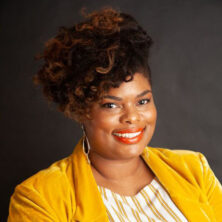Perspectives
Lilliann’s Story
As a young person, Lilliann noticed and named injustice when she saw it, and longed for spaces where she wasn’t the only one speaking up. Her story tells about her search for a community of practice and care. Lilliann’s time working with CoreAlign taught her to remove herself from spaces that didn’t value her and to see her own healing as part of her reproductive justice work.
There’s been a common thread in my life of noticing what is fair and what is not. My attitude has always been if what’s happening to a person is not right, I’m going to do what I can to help. The feedback I got as a child was “How dare you have something to say? Who are you to say anything?” But that didn’t stop me. I learned the rules and then I learned how to break them. I would calculate the cost and decide if I was willing to take the punishment so I could be heard or so that change could happen.
I went to school at a predominantly white institution. I remember writing in my middle school school newspaper how black history shouldn’t only be celebrated in February. In English class, when we got to pick words we wanted the class to learn to spell, I talked about spelling people of color’s names. Even if I couldn’t spell the name right, I was going to champion people of color. I always asked the question “why” and wasn’t satisfied until I had an answer that was acceptable to me. And I was the only in a lot of spaces, both at home and in school. I wondered why doesn’t everyone think this way? Why isn’t everyone else speaking up?
I found CoreAlign during my first job after grad school. I was responsible for providing backbone support to four different coalitions. I wanted to create programming that met people’s needs and reflected who they were. My job was to build the capacity of each coalition program manager, but no one listened to me. I experienced ageism, sexism, and repeated questioning of my degree. It was counter to what I thought working in public health would be. I had a desire to find groups of people where I wasn’t the only, where we had the same values as far as creating a sense of belonging and advocating for justice.
CoreAlign seemed like a good fit because it was work on undoing racism and reproductive justice. I thought, if no one’s listening to me here at least I can get this knowledge and bring it back. At CoreAlign, I wanted to come up with a strategy to incorporate a racial equity lens into my organization’s decision making processes. I wanted to create conditions that I could safely bring others into. Ultimately, CoreAlign taught me to remove myself from spaces that don’t value me.
After CoreAlign, I worked on a board of directors and several summit committees to create racial equity and accountability guidelines. This work involved collaboration with people who were in different parts of their journeys with racial justice, some of whom were causing harm while thinking they were doing good. Based on my work with CoreAlign, I knew we had to do this work collaboratively and that there wasn’t a blueprint for how to make it happen. During the process, I was told that I couldn’t do racial justice work because it wasn’t the approach that they were taking, and was initially not credited for my work. That was about three years ago and now the same groups are trying to figure out how to lead with racial equity and accountability. I was asked to be part of the work again and I said no. Instead, I leverage my position to connect people to national resources and others who do the work.
I feel like CoreAlign gave me tools to trust again and to identify who I want to be around. I learned that you have to acknowledge and use your superpowers, but also you have to protect yourself and practice self care. This work is about healing. We don’t just want to get through. We want to thrive.
